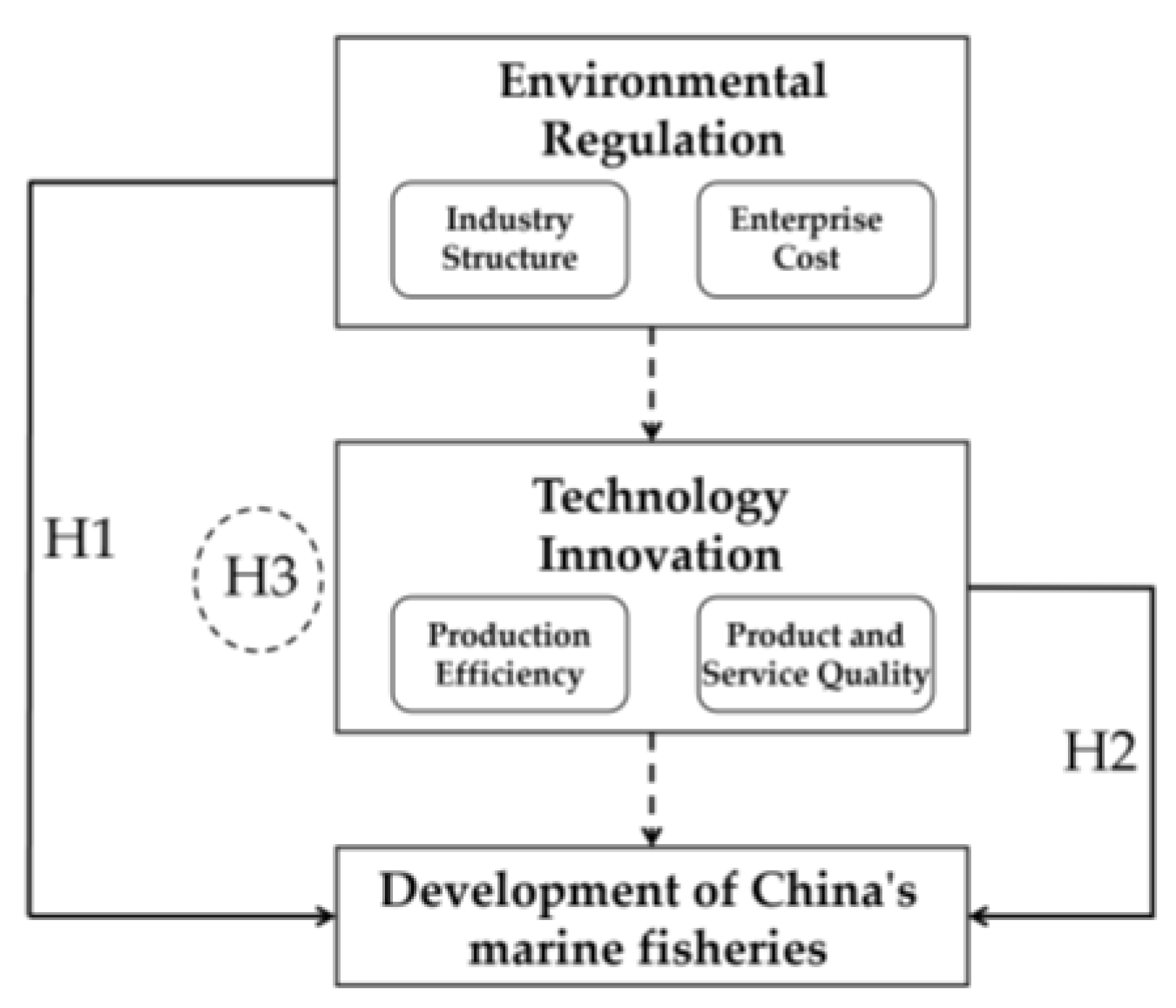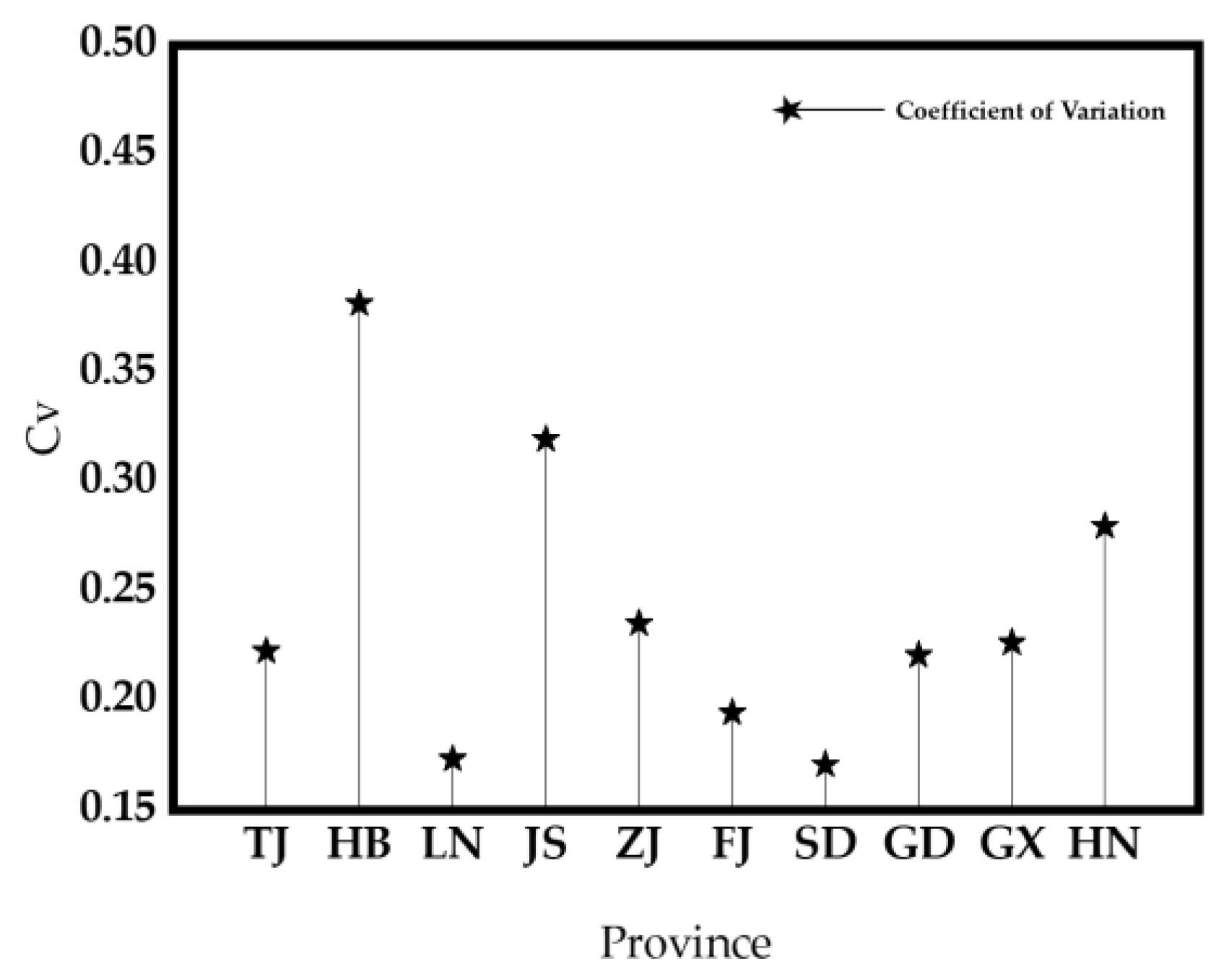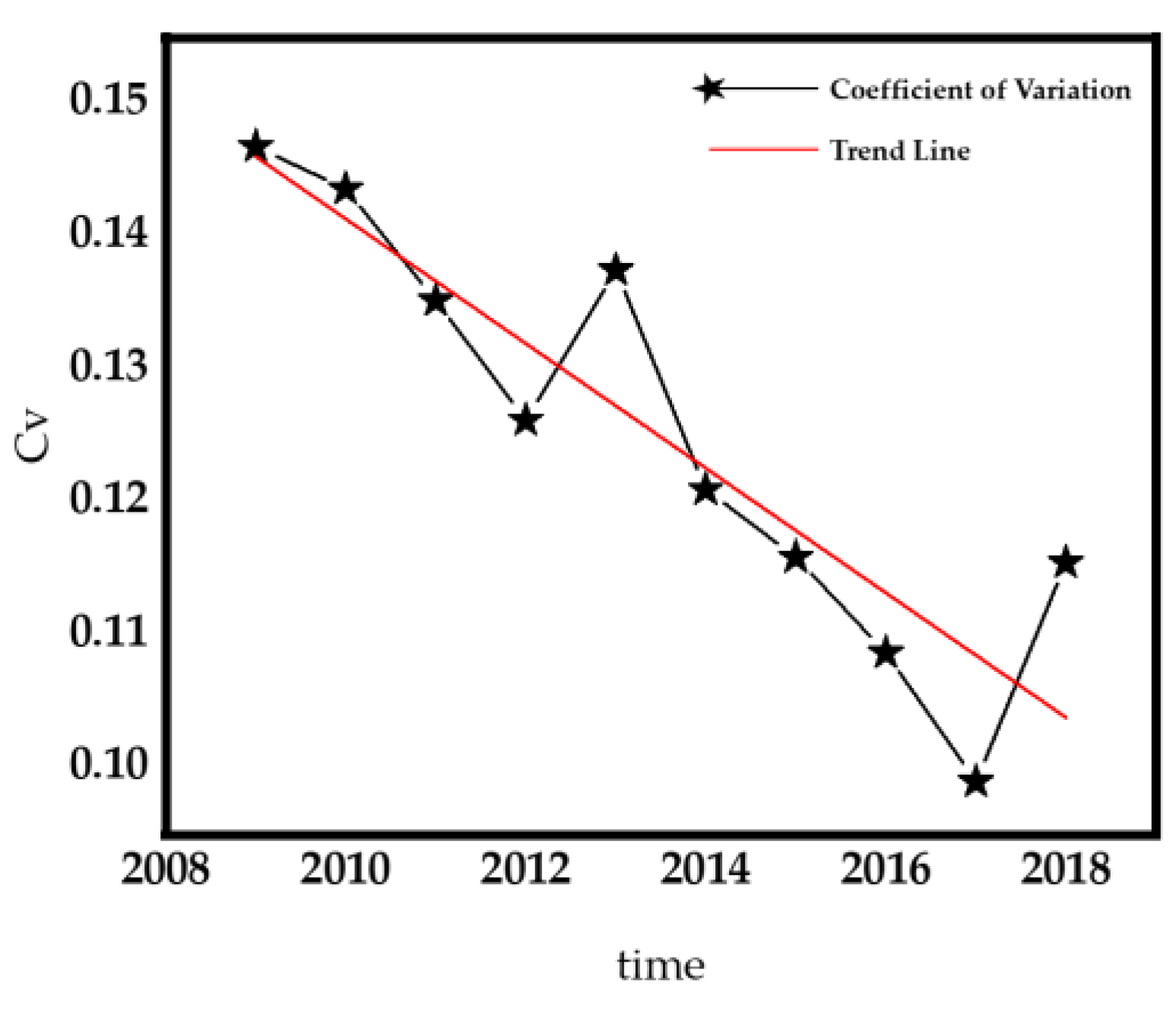Environmental Regulation, Technological Innovation and Development of Marine Fisheries—Evidence from Ten Coastal Regions in China
Abstract
:1. Introduction
2. Theoretical Analysis and Research Hypothesis
2.1. Environmental Regulation and Development of Marine Fisheries
2.2. Technological Innovation and Development of Marine Fisheries
2.3. The Mediating Effect of Technological Innovation
3. Measuring the Level of Development of China’s Marine Fisheries
3.1. Indicator System
3.2. Data and Method
3.3. Measurement Results and Analysis
3.3.1. Stages Analysis of Development of China’s Marine Fisheries
3.3.2. Differential Analysis of Development of China’s Marine Fisheries
4. Materials and Methods
4.1. Selection and Construction of Regression Models—Mediation Model
4.2. Variables and Data
4.2.1. Response Variable
4.2.2. Core Explanatory Variable
4.2.3. Mediating Variable
4.2.4. Control Variables
5. Results
5.1. Heteroskedasticity Test
5.2. Empirical Results
5.3. Robustness Tests
5.3.1. Replacing Variable
5.3.2. Adding Variable
6. Discussion
7. Conclusions
Supplementary Materials
Author Contributions
Funding
Institutional Review Board Statement
Informed Consent Statement
Data Availability Statement
Conflicts of Interest
References
- Ding, Q.; Chen., X.J.; Li, G. Catch statistics and the sustainable utilization of northwest pacific ocean fishery resources. Resour. Sci. 2013, 35, 2032–2040. [Google Scholar]
- Chen, S.Y.; Chen, D.K. Air pollution, government regulations and high-quality economic development. Econ. Res. J. 2018, 53, 20–34. [Google Scholar]
- Hua, J.; Hu, J.X. Analysis on the coupling relationship between technology innovation and high-quality economic development. Sci. Technol. Prog. Policy 2019, 36, 19–27. [Google Scholar]
- Gu, S.Z.; Wu, H.J.; Wu, Q.Q.; Yu, X.W. Innovation-driven and core technology breakthrough: The cornerstone of high-quality development. Chin. Soft Sci. 2018, 10, 9–18. [Google Scholar]
- Du, L.Z.; Zhao, Y.H.; Tao, K.T.; Lin, W.F. Compound Effects of Environmental Regulation and Governance Transformation in Enhancing Green Competitiveness. Econ. Res. J. 2019, 54, 106–120. [Google Scholar]
- Zhang, C.Y.; Guo, Y.Q. Can Pollution-intensive Industry Transfer Achieve Win-win Development in Economy and Environment? From the Perspective of Environmental Regulation. J. Financ. Econ. 2015, 41, 96–108. [Google Scholar] [CrossRef]
- Sadik-Zada, E.R.; Ferrari, M. Environmental Policy Stringency, Technical Progress and Pollution Haven Hypothesis. Sustainability 2020, 12, 3880. [Google Scholar] [CrossRef]
- He, W.H.; Zhang, Y.J. Environmental regulation, industrial restructuring and high-quality economic development: Ail analysis based on PVAR model of 11 provinces and cities in the Yangtze River economic belt. Stat. Inf. Forum 2021, 36, 21–29. [Google Scholar]
- Zha, J.P. Empirical Study of Environmental Regulation and Industrial Economic Growth Pattern: An Economic Growth Decomposition Perspective. Ind. Econ. Res. 2015, 3, 92–101. [Google Scholar] [CrossRef]
- He, X.B. Technological Innovation and Quality of Chinese Economic Growth: An Empirical Analysis Based on Provincial Panel Data. Forum. Sci. Technol. China 2019, 10, 24–32. [Google Scholar] [CrossRef]
- Hu, Z.L.; Xia, Q.; Sun, G.Y. Servitization, Technological Innovation and Industrial Structure Upgrading of Manufacturing Industry—Multinational Empirical Research Based on the Data of WIOD. Int. Econ. Trade Res. 2017, 33, 4–21. [Google Scholar] [CrossRef]
- Zhang, W.G.; Ji, L.; Laurette, D. Convergence innovation and its significance for China’s innovation-driven development. Manag. World 2016, 6, 1–9. [Google Scholar] [CrossRef]
- Naveedullah, M.; Lin, L.F. How Do Proactive Environmental Strategies Affect Green Innovation? The Moderating Role of Environmental Regulations and Firm Performance. Int. J. Environ. Res. Public Health 2021, 18, 9083. [Google Scholar] [CrossRef]
- Dong, L.H.; Yan, T.H.; Zou, Q. Institutional quality, extrusion effects of technology innovation and resource curse based on the empirical analysis of China’s provincial panel data. Science. Res. Manag. 2015, 36, 88–95. [Google Scholar] [CrossRef]
- Chevallier, A. Diversity of small-scale fisheries in Chile: Environmental patterns and biogeography can inform fisheries management. Environ. Sci. Policy 2021, 124, 33–44. [Google Scholar] [CrossRef]
- Guo, C.B. Incorporating environmental forcing in developing ecosystem-based fisheries management strategies. ICES J. Mar. Sci. 2020, 77, 500–514. [Google Scholar] [CrossRef]
- Haryadi, J. Fisheries technology innovation supports the Citarum Harum program. IOP Conf. Ser. Earth Environ. Sci. 2020, 521, 012010. [Google Scholar] [CrossRef]
- Eigaard, O.R.; Marchal, P.; Gislason, H.; Rijnsdorp, A.D. Technological development and fisheries management. Rev. Fish. Sci. Aquac. 2014, 22, 156–174. [Google Scholar] [CrossRef]
- Elmer, L.K.; Kelly, L.A.; Rivest, S.; Steell, S.C. Twardek. W.M.; Danylchuk. A.J. Angling into the future: Ten commandments for recreational fisheries science, management, and stewardship in a good Anthropocene. Environ. Manag 2017, 60, 165–175. [Google Scholar] [CrossRef]
- Sun, J.; Li, X.Q.; Chen, J.F.; Guo, S.J. Progress in oceanic biological pump. Haiyang Xuebao 2016, 38, 1–21. [Google Scholar] [CrossRef]
- Ducklow, H.W.; Steinberg, D.K.; Buesseler, K.O. Upper Ocean Carbon Export and the Biological Pump. Oceanography 2001, 14, 50–58. [Google Scholar] [CrossRef]
- Yin, Y.; Yang, H.Y.; Ping, Y. Spatial and temporal evolution of aquaculture in the Yangtze River Delta Region from 2008 to 2017. Chin. Fish. Econ. 2021, 39, 25–34. [Google Scholar]
- Sun, C.Z.; Yu, G.H.; Wang, Z.Y.; Liu, K.; Liu, G.C. Marine Carrying Capacity Assessment and Spatio-temporal Analysis in the Bohai Sea Ring Area, China. Sci. Geogr. Sin. 2014, 34, 513–521. [Google Scholar]
- Chen, H.L. Pan-Pearl River Delta Regional Fisheries Economic Cooperation Study. China Fish. 2010, 12, 22–24. [Google Scholar]
- Xu, G.Z. Nekton Marine. Sciences 1984, 1, 49. [Google Scholar]
- Yuan, Y.J.; Xie, R.H. Research on the Effect of Environmental Regulation to Industrial Restructuring—Empirical Test Based on Provincial Panel Data in China. Chin. Ind. Econ. 2014, 8, 57–69. [Google Scholar] [CrossRef]
- Cheng, Y.; Ren, J.L.; Chen, Y.B.; Xu, C.L. Spatial evolution and driving mechanism of China’s environmental regulation efficiency. Geogr. Res. 2016, 35, 123–136. [Google Scholar] [CrossRef]
- Tong, J.; Liu, W.; Xue, J. Environmental Regulation, Factor Input Structure and Industrial Transformation. Econ. Res. J. 2016, 51, 43–57. [Google Scholar]
- Long, X.N.; Wan, W. Environmental Regulation, Corporate Profit Margins and Compliance Cost Heterogeneity of Different Scale Enterprises. Chin. Ind. Econ. 2017, 06, 155–174. [Google Scholar] [CrossRef]
- Shi, L.L.; Zhao, J. Environmental regulation, technological innovation and industrial structure upgrading. Sci. Res. Manag. 2019, 6, 3–16. [Google Scholar] [CrossRef]
- Zhu, S.J.; Xie, X.; Duan, F. Manufacturing Servitization, Technological Innovation and Quality of Export Products. Econ. Rev. 2019, 6, 3–16. [Google Scholar] [CrossRef]
- Yuan, Y.J.; Chen, Z. Environmental regulation, green technology innovation and the transformation and upgrading of China’s manufacturing industry. Stud. Sci. Sci. 2019, 37, 1902–1911. [Google Scholar] [CrossRef]
- Chao, X.J.; Xue, Z.X. Research on the theoretical logic and practical mechanism of high quality of china’s economic development in the new era. J. Northwest Univ. (Philos. Soc. Sci. Ed.) 2018, 48, 12–22. [Google Scholar] [CrossRef]
- Liu, T.; Huang, Q. Economic efficiency versus economic effectiveness. Shanghai Stat. 1997, 10, 18–19. [Google Scholar]
- Cha, H.W.; Zheng, T.T. Resource dependence, industrial structure and economic development efficiency—analysis based on mediated transmission model. Res. Dev. 2018, 6, 14–22. [Google Scholar] [CrossRef]
- Liu, T.C. Examining the coupling degree and interactive stress between ecological environment and economic development in the yellow river basin. Yellow River 2021, 43, 13–18. [Google Scholar] [CrossRef]
- Run, J.Y.; Sun, Q.L. Temporal and spatial evolution of county economic difference since the establishment of Chongqing municipality. J. Southwest Univ. (Nat. Sci.) 2020, 42, 106–116. [Google Scholar] [CrossRef]
- Sodik, D.P.; Istiqomah, I. Economic Growth and Poverty: The Mediating Effect of Employment. JEJAK J. Ekon. Dan Kebijak. 2019, 12, 238–252. [Google Scholar] [CrossRef]
- Li, Y.Y.; Shen, K.R. Emission reduction effect of China’s pollution control policies—An empirical analysis based on inter-provincial industrial pollution data. Manag. World 2008, 07, 7–17. [Google Scholar] [CrossRef]
- Fahad, S.; Bai, D.B.; Liu, L.C.; Baloch, Z.A. Heterogeneous impacts of environmental regulation on foreign direct investment: Do environmental regulation affect FDI decisions? Environ. Sci. Pollut. Res. 2021. [Google Scholar] [CrossRef] [PubMed]
- Wang, B.; Wu, Y.R.; Yan, P.F. Environmental efficiency and environmental total factor productivity growth in China’s regional economies. Econ. Res. J. 2010, 45, 95–109. [Google Scholar]
- Zhang, C.; Lu, Y.; Yu, T.S. The intensity of environmental regulation and technological progress of production. Econ. Res. J. 2011, 46, 113–124. [Google Scholar]
- Sadik-Zada, E.R.; Loewenstein, W. Drivers of CO2-Emissions in Fossil Fuel Abundant Settings: (Pooled) Mean Group and Nonparametric Panel Analyses. Energies 2020, 13, 3956. [Google Scholar] [CrossRef]



| Target-Level | First-Level Indicators | Second-Level Indicators | Indicator Properties |
|---|---|---|---|
| Evaluation system for development of China’s marine fisheries | Economic Benefits | Fishery output value per fisherman | + |
| Average annual net income of fishermen | + | ||
| Fishery production value | + | ||
| Unit mariculture sea benefits | + | ||
| Industrial Structure | Industrial upgrading index | + | |
| Level of seawater products processing | + | ||
| Mariculture production as a proportion of total production | + | ||
| The proportion of recreational fishery output value to total fishery economic output value | + | ||
| Share of pelagic fishing in total fishing production | + | ||
| Total exports of fishery products as a proportion of total fishery production | + | ||
| Ecological Environment | Economic losses caused by fishery disasters as a proportion of the total economic output of fisheries | − | |
| Offshore water quality | + | ||
| Mariculture unit value-added equivalent pollutant emissions | − |
| Time | 2009 | 2010 | 2011 | 2012 | 2013 | 2014 | 2015 | 2016 | 2017 | 2018 | Mean | Ranking | |
|---|---|---|---|---|---|---|---|---|---|---|---|---|---|
| Provinces | |||||||||||||
| Tianjin | 0.3479 | 0.3491 | 0.3365 | 0.3975 | 0.2665 | 0.3794 | 0.3874 | 0.3712 | 0.3888 | 0.2957 | 0.3520 | 5 | |
| Hebei | 0.1749 | 0.1696 | 0.1743 | 0.1895 | 0.1824 | 0.1962 | 0.1909 | 0.2564 | 0.2954 | 0.2265 | 0.2056 | 10 | |
| Liaoning | 0.3970 | 0.3990 | 0.4078 | 0.4297 | 0.4071 | 0.4833 | 0.4639 | 0.4864 | 0.6237 | 0.4246 | 0.4523 | 2 | |
| Jiangsu | 0.2150 | 0.1708 | 0.2142 | 0.2075 | 0.2057 | 0.2403 | 0.2590 | 0.2638 | 0.2631 | 0.4152 | 0.2455 | 9 | |
| Zhejiang | 0.2626 | 0.2704 | 0.2995 | 0.3126 | 0.3063 | 0.3504 | 0.3774 | 0.3748 | 0.4270 | 0.3503 | 0.3331 | 7 | |
| Fujian | 0.3092 | 0.3358 | 0.3775 | 0.4005 | 0.3751 | 0.3937 | 0.4340 | 0.4471 | 0.5281 | 0.4292 | 0.4030 | 3 | |
| Shandong | 0.3392 | 0.3638 | 0.4003 | 0.4230 | 0.3957 | 0.4643 | 0.4804 | 0.5874 | 0.6206 | 0.5143 | 0.4589 | 1 | |
| Guangdong | 0.3121 | 0.3160 | 0.3199 | 0.3515 | 0.3310 | 0.3546 | 0.3572 | 0.3661 | 0.3839 | 0.4590 | 0.3551 | 4 | |
| Guangxi | 0.2902 | 0.3215 | 0.3251 | 0.3493 | 0.3294 | 0.3406 | 0.3983 | 0.4182 | 0.4492 | 0.2381 | 0.3460 | 6 | |
| Hainan | 0.2295 | 0.2461 | 0.2693 | 0.2867 | 0.2730 | 0.2897 | 0.2984 | 0.3155 | 0.2881 | 0.3057 | 0.2802 | 8 | |
| Variables | Name | Symbol | Description | Mean | Max | Min |
|---|---|---|---|---|---|---|
| Response Variable | The level of development of marine fisheries | Y | the score of marine fisheries development level measured by entropy method in this study | 0.3432 | 0.6237 | 0.1696 |
| Explanatory Variable | Environmental Regulation | reg | completed investment in wastewater/completed investment in the treatment of the three wastes | 0.2484 | 0.7126 | 0.00056767 |
| reg2 | 0.0948 | 0.5079 | 0.00000032 | |||
| Control Variables | Marketization index | market | the marketization index constructed by Fan and Wang | 8.12 | 10.83 | 4.98 |
| GDP per capita | gdp | total regional GDP/total population of the region | 4.67 | 8.97 | 1.46 | |
| Mediating Variable | Technology Innovation | TI | the number of fishing, aquaculture and fish processing patents | 40 | 176 | 0 |
| Model A | Model B | Model C | |
|---|---|---|---|
| p-value | 0.7094 | 0.1323 | 0.9695 |
| Explanatory Variables | Model A | Model B | Model C |
|---|---|---|---|
| Response Variables | |||
| lnY | lnTI | lnY | |
| lnreg | −0.1549 ** (0.0696) | 1.9243 * (1.0780) | −0.2007 *** (0.0660) |
| lnreg2 | 0.0869 ** (0.0395) | −0.9753 (0.6129) | 0.1101 *** (0.0374) |
| lnmarket | −0.0704 (0.0482) | 1.6385 ** (0.7469) | −0.1094 ** (0.0462) |
| lngdp | 0.0743 *** (0.0198) | 1.2627 *** (0.3068) | 0.0442 ** (0.0200) |
| lnTI | 0.0238 *** (0.0062) | ||
| Intercept term | 0.3385 *** (0.0870) | −2.7430 ** (1.3479) | 0.4038 *** (0.0830) |
| Robustness Test(I) | Robustness Test (II) | |||||
|---|---|---|---|---|---|---|
| Explanatory Variables | Model A | Model B | Model C | Model A | Model B | Model C |
| Response Variables | ||||||
| lnY | lnTI | lnY | lnY | lnTI | lnY | |
| lnreg | −0.1549 ** (0.0696) | 3.4937 *** (1.2289) | −0.2151 *** (0.0697) | −0.1591 ** (0.0698) | 2.0931 ** (1.0563) | −0.2148 *** (0.0656) |
| lnreg2 | 0.0869 ** (0.0395) | −1.5358 ** (0.6987) | 0.1133 *** (0.0388) | 0.0870 ** (0.0396) | −0.9798 (0.5991) | 0.1131 *** (0.0369) |
| lnmarket | −0.0704 (0.0482) | −0.1195 (0.8515) | −0.0684 (0.0461) | −0.0728 (0.0483) | 1.7326 ** (0.7313) | −0.1188 ** (0.0458) |
| lngdp | 0.0743 *** (0.0198) | 0.0764 (0.3497) | 0.0730 ** (0.0190) | 0.0752 *** (0.0198) | 1.2259 *** (0.3003) | 0.0426 ** (0.0198) |
| lnmaster | −0.0047 (0.0054) | 0.1904 ** (0.0818) | −0.0098 * (0.0051) | |||
| lnTI | 0.0172 *** (0.0056) | 0.0266 *** (0.0063) | ||||
| Intercept term | 0.3385 *** (0.0870) | 5.3659 *** (1.5366) | 0.2460 *** (0.0885) | 0.3646 *** (0.0920) | −3.7932 *** (1.3927) | 0.4656 *** (0.0880) |
Publisher’s Note: MDPI stays neutral with regard to jurisdictional claims in published maps and institutional affiliations. |
© 2022 by the authors. Licensee MDPI, Basel, Switzerland. This article is an open access article distributed under the terms and conditions of the Creative Commons Attribution (CC BY) license (https://creativecommons.org/licenses/by/4.0/).
Share and Cite
Li, Y.; Kong, J.; Ji, J. Environmental Regulation, Technological Innovation and Development of Marine Fisheries—Evidence from Ten Coastal Regions in China. Fishes 2022, 7, 20. https://doi.org/10.3390/fishes7010020
Li Y, Kong J, Ji J. Environmental Regulation, Technological Innovation and Development of Marine Fisheries—Evidence from Ten Coastal Regions in China. Fishes. 2022; 7(1):20. https://doi.org/10.3390/fishes7010020
Chicago/Turabian StyleLi, Yutong, Jiaojiao Kong, and Jianyue Ji. 2022. "Environmental Regulation, Technological Innovation and Development of Marine Fisheries—Evidence from Ten Coastal Regions in China" Fishes 7, no. 1: 20. https://doi.org/10.3390/fishes7010020
APA StyleLi, Y., Kong, J., & Ji, J. (2022). Environmental Regulation, Technological Innovation and Development of Marine Fisheries—Evidence from Ten Coastal Regions in China. Fishes, 7(1), 20. https://doi.org/10.3390/fishes7010020





